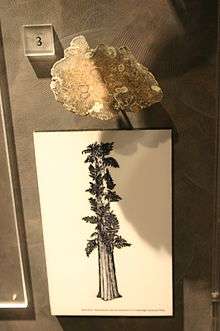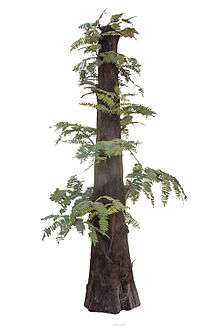Tempskya
Tempskya is an extinct genus of tree-like fern that lived during the Cretaceous period. The genus is known from several petrified specimens from various locations across the Northern Hemisphere.[2] Specimens have also been recovered in Argentina and Australia.[3]
| Tempskya | |
|---|---|
 | |
| Tempskya fossil slab and reconstruction on display | |
| Scientific classification | |
| Kingdom: | Plantae |
| Clade: | Tracheophytes |
| Class: | Polypodiopsida |
| Subclass: | Polypodiidae |
| Order: | incertae sedis |
| Family: | †Tempskyaceae |
| Genus: | †Tempskya Corda (1845)[1] |
Description
Specimens of Tempskya could grow to be up to 14.75 feet (4.5 meters) tall.[2] Its trunk was actually a large collection of stems surrounded by adventitious roots.[2] The false trunk could be up to 50 cm in diameter.[4] Thin leaves have been discovered for the first time on T. wyomingense specimens;[1] the more commonly seen fossilized leaf bases show that they covered the upper part of the trunk.[2]
Hypothesized growth pattern
Examination of cross sections of various Tempskya specimens shows that those with the largest trunks have the smallest number of stems, and vice versa.[4] From this, a possible growth pattern of Tempskya has been suggested: at the sporeling stage, Tempskya would consist of a single stem, which would begin to branch off distally. A "mantle" of adventitious roots would then develop around the stems to support them. Later on, many of the stems would begin to decay, while the adventitious roots would still provide support and absorb water for the grown plant.[4] This growth pattern has also been hypothesized for Psaronius.[4]
Taxonomy

Tempskya was originally described in 1824 as Endogenites erosa before being described as Tempskya by August Carl Joseph Corda in 1845.[1] The four species originally described by Corda were, in order: T. pulchra, T. macrocaula, T. microrrhiza, and T. schimperi.[5]
Tempskya is the sole member of the family Tempskyaceae.[2] The family has been placed in the order "Filicales",[4] which is now split into a number of orders of leptosporangiate ferns.
Fossil sites
Tempskya finds were thought to be exclusive to the Northern Hemisphere until specimens were discovered in Argentina and Australia (in 2003 and 2005, respectively). Tempskya fossils have also been discovered in the Czech Republic (2002) and Japan (1986).[3] Tempskya were frequently found fluvial deposited in gravel pits in Germany. Its origin is not clear, in part they came certainly from Czech sites.
References
- Tidwell, William D.; Hebbert, Naomi (September 1992). "Species of the Cretaceous Tree Fern Tempskya from Utah". International Journal of Plant Sciences. 153 (3): 513–528. JSTOR 2995693.
- Palmer, Douglas; et al. (2009). Prehistoric life : the definitive visual history of life on earth (1st American ed.). New York: Dorling Kindersley. p. 286. ISBN 978-0-7566-5573-0.
- Gee, Carole T. (2010). "Oldest Known Dicotyledonous Lianas From the Early Late Cretaceous of Utah and New Mexico, U.S.A.". Plants in Mesozoic time : morphological innovations, phylogeny, ecosystems (illustrated ed.). Bloomington: Indiana University Press. p. 271. ISBN 0-253-35456-0. Retrieved 25 January 2012.
- Taylor, Thomas N.; Taylor, Edith L.; Krings, Michael (2009). "Ferns and Early Fernlike Plants". Paleobotany : the biology and evolution of fossil plants (2nd ed.). Amsterdam: Academic Press. pp. 457–459. ISBN 0-12-373972-1. Retrieved 24 January 2012.
- Stephenson, Lloyd William (1936). "American Cretaceous Ferns of the Genus Tempskya". New Upper Cretaceous Ostreidae From the Gulf Region. Washington: United States Government Printing Office. p. 108. Retrieved 25 January 2012.